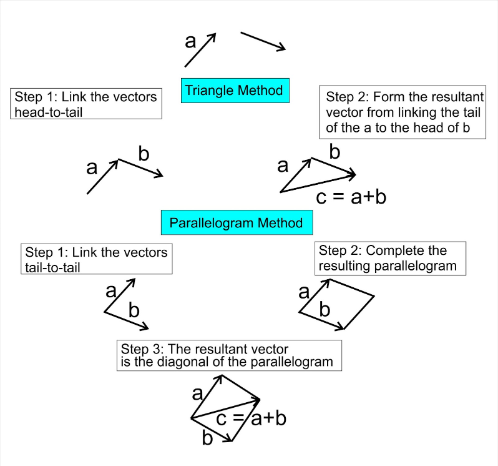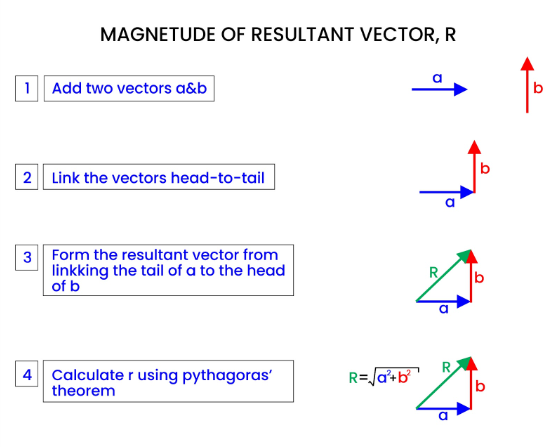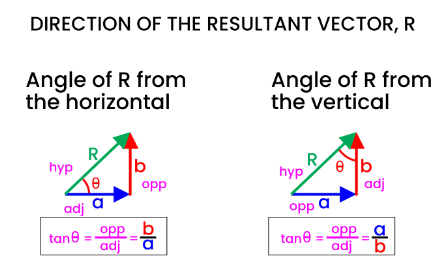Adding Vectors
Adding Vectors
- One way to produce a resultant vector is by adding or subtracting vectors
- This resultant vector is also known as the “net” vector, such as in the case of the net force.
- There are two techniques to add vectors:
- Calculation – which is applicable when the vectors are perpendicular
- Scale drawing – which is used when the vectors are not perpendicular
Combining Vectors Using a Scale Diagram
- There are two methods to combine vectors using a scale diagram – the triangle method and the parallelogram method.
- To use the triangle method:
- Step 1: link the vectors head-to-tail
- Step 2: connect the tail of the first vector to the head of the second vector to form the resultant vector
- To use the parallelogram method:
- Step 1: link the vectors tail-to-tail
- Step 2: complete the resulting parallelogram
- Step 3: The diagonal of the parallelogram represents the resultant vector.

Combining Vectors by Calculating
- Combining vectors by calculation involves two steps:
- First, the direction of the resultant vector is determined using trigonometry.
- Second, the magnitude of the resultant vector is calculated using Pythagoras theorem.

- To determine the direction of the resultant vector, the angle it makes with the horizontal or vertical axis is calculated using trigonometry.
- It’s important to specify which angle is being referred to (e.g. calculate the angle from the x-axis).
- Trigonometry can be used to calculate the angle between the resultant vector and the horizontal or vertical axis.
- Depending on which vector magnitudes are known, either the sine, cosine or tangent formula can be used.

WORKED EXAMPLE
Suppose a swimmer is swimming due north at a speed of 2 m/s while a current flows to the east at a speed of 5 m/s.
To determine the swimmer’s resultant velocity:
Step 1: Draw a diagram that includes all known values.
Step 2: Use Pythagoras’ theorem to calculate the magnitude of the resultant velocity.
Step 3: Use trigonometry to calculate the angle between the resultant velocity and the horizontal or vertical axis.
Step 4: Write the answer, including both magnitude and direction of the velocity, as well as all units.
The swimmer’s velocity is 5.4 m/s at an angle of 22 degrees to the horizontal direction.
Vectors are quantities that have both magnitude and direction. They are used to represent physical quantities such as displacement, velocity, acceleration, force, and momentum.
To add vectors, you need to break them down into their components (x and y) and then add the corresponding components together. You can use trigonometry to find the magnitudes and angles of the components.
Vector addition is the process of combining two or more vectors to form a resultant vector. The resultant vector is the sum of the individual vectors.
The parallelogram method involves drawing the two vectors as sides of a parallelogram and then drawing the diagonal to find the resultant vector.
The magnitude of a vector is the length of the vector. You can use the Pythagorean theorem to find the magnitude of a vector by adding the squares of its components and taking the square root of the sum.
The direction of a vector is the angle it makes with the positive x-axis. You can use trigonometry to find the angle by dividing the y-component by the x-component and taking the inverse tangent of the quotient.
Unit vectors are vectors that have a magnitude of 1. They are used to represent directions and are often written in the form of i, j, and k to represent the x, y, and z-axes, respectively.
The dot product of vectors is a scalar quantity that represents the product of the magnitudes of the vectors and the cosine of the angle between them. It is used to find the angle between vectors and to project one vector onto another.
The cross product of vectors is a vector quantity that represents the product of the magnitudes of the vectors and the sine of the angle between them. It is used to find the direction of a vector perpendicular to two other vectors.
Vectors are used in many areas of physics, such as mechanics, electromagnetism, and thermodynamics. They are used to represent physical quantities such as forces, velocities, and electric fields, and are essential for understanding the behavior of physical systems.





Still got a question? Leave a comment
Leave a comment